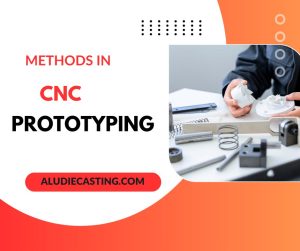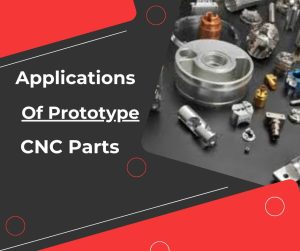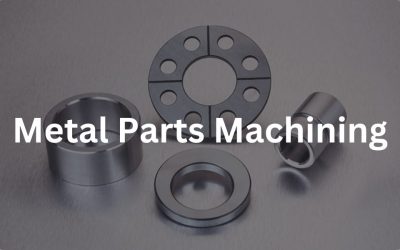What is Prototype CNC Machining?
Prototype machining brings product development ideas to reality. It applies computer-controlled devices, such as CNC machines, to create real models or prototypes of a design.
Consider it as converting a computer blueprint into an actual product, precisely like 3D printing but with many significant advantages:
- Rapid prototyping: Create prototypes faster than manual handicrafts or other standard methods.
- Greater accuracy: Prototype machining provides precise measurements and complex details for prototypes with strict tolerances. Prototype machining guarantees that these specifications are accurate.
- Improved material choice: Use different materials such as plastics and metals (steel, aluminum) to guarantee the result is suited. This allows you to test for fit and longevity by making a phone case prototype from the same plastic as the finished design.
- Practical prototypes: Create functional designs that enable structure, fit, and function testing. Consider a functioning model of a new surgical tool prototype. CNC machining allows you to test the tool’s grip, mobility, and interaction with simulated tissue.
Prototype CNC Parts: Material, Design Time, and Estimated Cost
| Material | Design Time (Hours) |
Estimated Cost Range
|
| Aluminum (6061) | 2-4 | $50 – $200 |
| Acrylic | 1-3 | $30 – $150 |
| Brass | 3-5 | $100 – $300 |
| Stainless Steel (304) | 4-6 | $150 – $400 |
| ABS Plastic | 1-2 | $20 – $100 |
| Polycarbonate (PC) | 2-3 | $30 – $150 |
| Polypropylene (PP) | 1-2 | $25 – $125 |
| High-Density Polyethylene (HDPE) | 1-2 | $20 – $100 |
Prototype machining helps you to create and test a physical copy of the design idea quickly, accurately, and with the appropriate materials. This guarantees a successful final product and accelerates the product development process.
This article explores five rapid prototyping methods recommended for various applications. What is the significance of prototypes in design evaluation, testing, and production processes? It mentions various uses of prototypes, such as proof-of-concept, crowdfunding campaigns, and bridges to total production.
Top 5 Rapid Prototyping Methods
CNC Machining
CNC Machining is suitable for projects requiring mechanical solid parts with precise tolerances. It can work with various materials and offers fast turnaround times. However, it may not be ideal for thin-walled or deep-cavity designs.
Polyurethane Vacuum Casting (VC):
This method uses a silicone rubber mold and casting resin to create near-production-quality plastic parts. It offers versatility in material properties, finishes, and hollow forms. However, the silicone molds have a limited lifespan.
Stereolithography (SLA):
This established 3D printing method uses a UV laser to cure liquid resin into solid plastic prototypes. It offers a good surface finish and various resin options but requires post-processing steps and special storage due to material properties.
Fused Deposition Modeling (FDM):
The most popular 3D printing method, FDM uses plastic filaments to create prototypes layer by layer. It’s cost-effective and readily available, but its lower resolution may require more finishing work.
Powder Bed Fusion:
This method includes Selective Laser Sintering (SLS) and Multi-Jet Fusion (MJF). Both use powdered materials to build prototypes. They offer self-supporting parts, efficient use of build volume, and material cost savings in SLS.
Prototyping in Machining
Prototype CNC Parts
CNC (Computer Numerical Control) machining is a modern manufacturing method that revolutionizes the product development business. In contrast with other traditional methods that form materials manually, CNC machining requires the ability of computers to provide fantastic precision and control. CNC machining works by extracting material from a solid block and forming it into the desired final shape. This is performed using predefined instructions or coding. Consider a CNC machine operating like a sculptor with a chisel; instead of depending only on human skills, it follows an accurate digital plan.
Design
The process starts with a CAD file and your prototype’s blueprints. It provides precise details regarding the final product’s dimensions, size, and shape.
G-code Translation
When you have your CAD file, G-code translates it into a language the CNC machine can understand using special software. G-code is a set of encoded instructions or commands instructing the machine to move its cutting tools and remove materials from the object.
Following the path:
Toolpaths G-code defines the overall shape and specific path the cutting tool must take. These paths are known as toolpaths. They ensure the machine extracts material quickly and efficiently to produce the final geometry.
Multiple Tools for Multiple Tasks
Depending on how complex your prototype is, various methods are available in this CNC machining field. Two standard methods are as follows:
CNC Milling
CNC milling is a versatile method. This method removes materials from a fixed workpiece using a spinning cutting tool. CNC milling has many types. The most common milling is 3-axis. The 3-axis allows movement along the X, T, and Z axes. Other advanced milling types are 4- and 5-axis. These milling types have excellent rotational capabilities. They create more complex and advanced geometries. These are best for objects with various angles and curved surfaces.
CNC Turning is a well-known method for creating rotating elements such as shafts, cylinders, and gears. The workpiece spins as a fixed cutting tool, which removes material to get the desired shape.
These basic concepts enable CNC machining to discover infinite ideas for producing highly accurate and valuable prototypes. Prototype CNC machining works with various tools and techniques and completely changes product development.
Parts of a CNC Mill
Although CNC machining seems to be high-tech, the art of magic, a better knowledge of its fundamental elements leads to a clearer image. Below is an overview of the main contributors in a CNC mill:
- Machine Column and Base: The machine’s base and column perform the same purpose as a robust workbench. They provide precise and fluid movements and a strong foundation for the machining procedure.
- Spindle and Cutting Tool: Consider the spindle, a high-speed motor supporting the cutting tool. Together, these dynamic forces create the needed shape in the workpiece. The cutting tool removes material while the spindle rotates it at high speeds.
- NC Control Unit: The control unit controls the rotation of the axes and spindle by reading the G-code instructions, a digital blueprint. It acts as the conductor for the whole machining process.
- X, Y, Z Axes (3-axis milling): These three linear axes (X-axis for left-to-right movement, Y-axis for front-to-back movement, and Z-axis for up-down movement). They allow for the perfect movement of the cutting tool. In simple language, they set the cutting tool precisely where it’s supposed to be to remove material.
- Worktable and Fixtures: The work table safely secures the workpiece during machining. Consider it a clamp that secures your project. Fixtures are also helpful tools for supporting complicated parts to ensure they stay stable during the machining process.
What Makes Prototype CNC Machining the Best Option?
Every decision matters in manufacturing. Prototype CNC machining is unique in the prototyping process due to its many advantages.
Why Prototype CNC machining can be the best choice for your job? There are many benefits of prototype CNC machining. Some are given below.
Reliability in Precision
CNC machining is remarkable for its ability to create products with precise dimensions. This is especially necessary for prototypes that require precise tolerances. Prototype CNC machining ensures that the prototype meets the particular needs of the finished product.
For example, a prototype of any new engine part can face performance issues if there are even slight dimensional tolerances. Prototype CNC machining ensures precision machining and high accuracy for perfect performance.
Materials Choice
CNC machining offers outstanding material variation compared to prototyping processes limited to particular materials. It can be used with various materials, such as composite materials, different plastics (including ABS and nylon), and metals (such as steel, aluminum, and stainless steel). This allows you to make prototypes with material properties almost match the final product.
Think about manufacturing a new phone case. CNC machining allows you to work with the same plastic as the final product, making it possible to compare its strength and feel more precisely.
Real-World Prototypes
One of CNC machining’s most significant advantages is its capacity for making functional prototypes. CNC machining allows you to create prototypes that can endure extreme manufacturability testing for shape, fit, and even function, compared to traditional processes that could result in non-functional models. This allows you to judge your design’s performance in real-world circumstances.
Think about creating a working model of an innovative healthcare prototype using CNC machining. This allows you to test the device’s grip, mobility, and contact with simulated tissue.
Improving Efficiency
Product development is a time-consuming activity. CNC machining excels at fast turnaround times. Compared to traditional methods like casting or handcrafting, it produces prototypes quickly, allowing for a quick cycle of design changes.
Digital and modern technology is the key to CNC machining’s success. Because prototypes are made using digital CAD models, they are easy to customize.
Are you looking to improve your design iteration according to your specific requirements? You need to update your CAD file. The CNC machine will quickly produce a new prototype that meets your specifications. This versatility of CNC machining enables the analysis of various choices and accelerates the design process.
Applications of Prototype CNC Machining
The versatility of prototype CNC machining supports many industries. It also helps them to realize their ideas with great accuracy and functionality.
Below are the most common applications of CNC machining:
Aerospace and Defense
CNC machining provides a way for development in the challenging field of aerospace and defense. It is necessary for producing complex and precise defense prototypes for spaceships, airplanes, and essential military equipment. Imagine a new rocket engine component prototype. CNC machining ensures precise details and tolerances required for maximum performance and safety.
Automotive and Transportation
Prototype CNC machining is necessary for the automotive and transportation industries, taking ideas from ideas to roadworthy reality. It produces automation prototypes for car body sections and engine parts like pistons and gears. This also allows engineers to test shape, function, and fit before starting mass production.
Medical Equipment
Precision is essential in the field of medical development. CNC machining is helpful when creating highly accurate and safe medical device prototypes for surgical equipment and devices. Consider a new surgical drill prototype. CNC machining guarantees precise measurements and a perfect surface for sensitive medical procedures.
Home Appliances and Electronics
Many modern home appliances and devices we use daily start as CNC machined prototypes. This approach enables the creation of appliance prototypes, enclosures, and even working consumer electronics prototypes.
Conclusion
Prototype CNC machining is an innovative force in the product development process. It accelerates the design process and promotes innovation by providing extraordinary precision, material variation, and the capability to build functional prototypes. The future of CNC machining is very bright. In the future, CNC machining will keep evolving. Advanced CNC technologies provide the opportunity to combine additive manufacturing integration with even more automation and perfection.







0 Comments